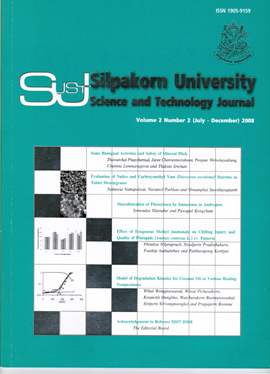Masculinization of Flowerhorn by Immersion in Androgens
Main Article Content
Abstract
This research objective was to investigate the effects of two synthetic androgens, 17 α-methyltestosterone(MT) and mesterolone, on sex reversal in flowerhorn fish by hormonal immersion with the aim of introducing anew method for producing all-male flowerhorn progeny. In this study, 6 days post-hatched fry (swim-up stage)were immersed with either MT or mesterolone at different concentrations (125, 250 or 500 μgL-1). One hundredand forty swim-up fry were allocated to each of 21 100-L aquaria. Experimental fishes were exposed tohormone for 24 hours before 10 L of water was added and the first water change (approximately 80%) wasdone on day 5. Fish were reared until they reached the size that histological examinations of gonad can beperformed (4 months). At 120 days of age, gonads were dissected for microscopic observation. Deviations ofmale ratios of hormone-treated fish from control were analyzed by Chi-square test. The populations of fishwhich the average of 62.88, 65.48 and 62.37% males in 125, 250 and 500 μgL-1 MT-treated groups, and 67.90,84.94 and 75.12% males in 125, 250 and 500 μgL-1 mesterolone-treated groups, respectively were obtained.Control fish had an average male ratio of 58%, and this percentage was used as an expected ratio forChi-square test. Immersion in MT at 250 μgL-1 resulted in significantly skewed sex ratio towards male (P <0.05). Male ratios of fish obtained from mesterolone immersions at all concentrations were also significantlydifferent from a male ratio of the control treatment (P < 0.01). Of the concentrations used in the present study,we were unable to produce all-male progeny. However, immersion with mesterolone at 250 μgL-1 was the mosteffective concentration that significantly skewed sex ratio, resulting in 27% male higher than that of untreatedfish. Based on the results of this study, we therefore suggested that hormonal immersion using mesterolone at250 μgL-1 was an applicable method for sex reversal in flowerhorn fish.
Downloads
Article Details
References
Devlin, R. H. and Nagahama, Y. (2002). Sex determination and sex differentiation in fish: an overview of genetic, physiological, and environmental influences. Aquaculture, 208: 191-364.
Gale, W. L., Fitzpatrick, M. L., Contreras-Sanchez, W. M., and Schreck, C. B. (1999). Masculinization of Nile tilapia (Oreochromis niloticus) by immersion in androgens. Aquaculture, 178: 349-357.
Hemat, R. A. S. (2004). Principles of Orthomolecularism. Urotext, London.
Pandian, T. J. and Kirankumar, S. (2003). Recent advances in hormonal induction of sex-reversal in fish. Journal Applied Aquaculture, 13: 205-230.
Petchjul, K. (2005). Effects of synthetic androgens on sex reversal and gonadal development of the hybrid, Thai Red Tilapia (Oreochromis sp.).Proceedings of 43rd Kasetsart University Annual Conference, Thailand, 1-4 February, 2005.
Wassermann, G. J. and Afonso, L. O. B. (2002). Validation of aceto-carmine technique for evaluating phenotypic sex in Nile tilapia (Oreochromis niloticus) fry. Ciencia Rural, Santa Maria, 32(1): 133-139.
Wassermann, G. J. and Afonso, L. O. B. (2003). Sex reversal in Nile tilapia (Oreochromis niloticus Linnaeus) by androgen immersion. Aquaculture Research, 34: 65-71.

